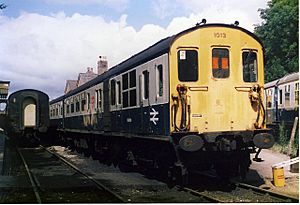British Rail Class 202 facts for kids
Quick facts for kids British Rail Class 202 |
|
|---|---|

Unit 1013
|
|
| In service | 1957–1986 |
| Manufacturer | Eastleigh and Ashford railway works |
| Number built | unknown |
| Formation | 6 cars per trainset |
| Operator(s) | British Rail |
| Specifications | |
| Maximum speed | 75 mph |
| Prime mover(s) | 2x English Electric 4SRKT Mark II |
The British Rail Class 202 was a special type of train used in the UK. These trains were known as diesel-electric multiple units (often shortened to DEMUs). This means they carried their own engines and didn't need a separate locomotive to pull them. They were also called the "6L" class.
These trains were built between 1957 and 1958 at two railway workshops: Eastleigh and Ashford. They were designed to run on a specific route from London Charing Cross to Hastings.
Contents
Why Was the Class 202 Special?
The Class 202 trains had a unique design feature that made them stand out.
Narrow Body for Tunnels
The railway line from London to Hastings had several tunnels. These tunnels were quite old and narrow. Because of this, regular-sized trains couldn't fit through them safely. To solve this problem, the Class 202 units were built with a special, narrower body shape. This allowed them to travel through the tight tunnels without any issues.
How Did They Work?
Each Class 202 train was made up of six connected carriages. They used two powerful English Electric engines to generate electricity, which then powered the train's motors. This made them quite fast for their time, reaching speeds of up to 75 miles per hour.
Where Did They Run?
The main job of the Class 202 trains was to provide passenger services between London and Hastings. This route was important for people traveling between the capital city and the coastal town.
Years of Service
These trains served the British Rail network for many years. They started carrying passengers in 1957 and continued to do so until 1986. After nearly 30 years of service, they were eventually replaced by newer, more modern trains.

